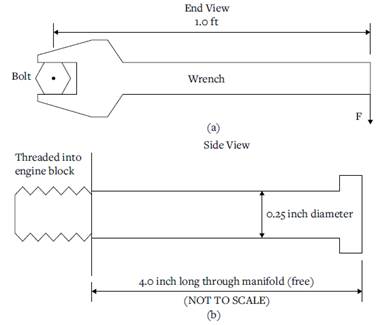10. The exhaust manifold on a car engine needs to be replaced. The manifold is held in place by one-fourth-inch diameter steel bolts that pass through holes in the manifold and thread into the cast iron engine block (i.e., the bolts are free to rotate within the holes in the manifold). The “free” length of the bolts (the length not screwed into the engine block) is 4.0 inches. Due to time and exposure to the elements during the operation of the car, the bolts have rusted in the engine block. To try to remove the bolts, a mechanic will apply a force on the end of a 1.0-foot-long wrench handle. The mechanic doesn’t want to break the bolts during the process of trying to remove them, so he did some research and estimated the shear strength of the bolts is 75,000 psi and the shear modulus is G = 11.5 × 106 psi.

a. If the shear stress induced in the bolt from the wrench is not to exceed the shear strength (thus breaking the bolt), what is the maximum force the mechanic can apply at the end of the wrench handle?
b. If the bolts turn when the mechanic applies 15 pounds of force to the wrench handle, what is the maximum shear stress and shear strain in the bolt? What is the angle of twist that will be observed at the wrench, in degrees?

